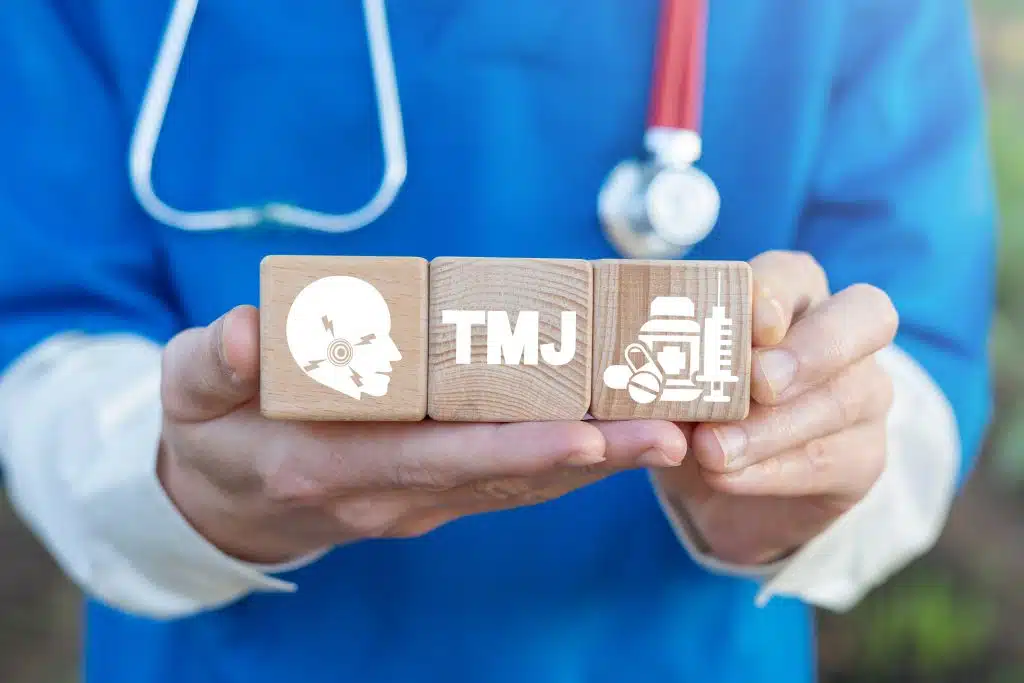If you’re experiencing symptoms of temporomandibular joint dysfunction, exercises for your TMJ can help. In fact, non-surgical therapies like massage, splints, and jaw exercises for TMJ are preferred over surgical intervention.
Warning: Jaw Exercises for TMJ
As a type of physical therapy, TMJ pain relief exercises are ideal for individuals experiencing chronic TMJ disorder, joint pain, or are trying to avoid surgery.
Keep in mind that being overzealous about temporomandibular joint disfunction exercises could actually make symptoms worse. All TMJ pain relief exercises should be performed as prescribed by our San Diego providers. If the exercises are not performed correctly, pain may become more severe or joint damage could possibly occur.
Start Small
It’s best to limit your jaw motion to smaller movements in the beginning. When you’re eating, take smaller bites and start out with softer textures of foods. Chewy or hard foods—including chewing gum—place too much strain on the joint and could cause relapse or painful flare-ups.
You may find that it’s easier to eat smaller amounts more frequently than it is to eat a full meal three times a day. As your joint improves, you can shift back to a more typical eating schedule.
Stretch and Massage
Place your fingertips on either side of your face, just in front of your TMJ joints. Apply gentle pressure and rub in a circular motion as you open and close your mouth. Take things slowly. Gradually move your fingertips to other pressure points across your jaw, temples, and even your forehead as you continue to open and close your joints.
Some people see significant TMJ pain relief by scheduling regular head, neck, and facial massages. Since joint tension radiates into muscles throughout the face and shoulders, professional massage therapy is extremely helpful.
Don’t Forget the Warm, Moist Compress
Apply moist heat is great for sore joints, including your TMJ. It’s best to only apply warm compresses for about 20 minutes at a time, so consider using it on one side, re-heating it, then applying it to the other side, such as when you’re winding down for the evening.
Relaxation Exercises
In addition to traditional physical exercise, mindfulness and relaxation are important aspects of TMJ therapy. These exercises focus more on easing tension in the joint. When your TMJ isn’t engaged, your mouth should be resting in a position where your lips are closed but the upper and lower teeth are not physically touching one another. Practice this relaxed position by setting timers throughout the day or trying to be aware of your muscle engagement.
If you catch yourself clenching your teeth throughout the day or when you wake up in the morning, the excess muscle tension will counteract any of the physical therapy or exercises you’ve been doing throughout the week.
When Exercises Aren’t Enough
TMJ specialists often recommend trying non-invasive therapies for TMJ disorder before something extreme like surgery. For instance, fitting you with a custom bite splint can provide natural joint and muscle relief by positioning your jaws in a resting position. But these appliances need to be created by a dental professional, as over-the-counter versions may actually cause more harm than good.
Some dental experts will also recommend using injectables to serve as natural muscle relaxers, such as botulinum toxin (the main ingredient in BOTOX cosmetics.) These medications ease muscle tension where administered, allowing them to provide added relief of TMJ symptoms and even migraine headaches for several months at a time.
It’s also important to have your bite evaluated, as irregular tooth placement or alignment could contribute to joint pain. Especially if you are having to chew your food in an irregular manner on a daily basis.
TMJ Treatment | San Diego
San Diego Sleep & TMJ Center offers professional advice on joint therapy and TMJ pain relief exercises to get you on the road to recovery. If you’re looking for TMJ treatment, San Diego patients trust our providers for an honest, holistic approach to their joint disorders. For more information on TMJ treatment, call San Diego Sleep & TMJ Center today for an exam.


